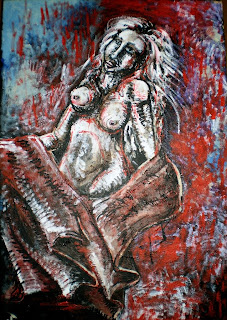INTERVIEW: The Morrígan - Interview with Artist Joseph Cilia - Part II
Interviewer: Ben Kesp
Interview (Part 1) with Maltese artist Joseph Cilia on the Morrighan, the inspiration behind two of his most personal works.
This is Part II, the interview conclusion about this elusive Celtic goddess.
Interview Part II:
BK – Phantom Queen, Great Queen, Goddess of Death & Rebirth, Crow Goddess; she has been called by many names. What role do you think she plays in our lives today?
JC - I think she fulfills all of the roles – but more so as Goddess of Death and Rebirth. The reason being that in times like the ones we are living in, death is always present however in a more subtle way. People are seemingly becoming ever more disillusioned by the old traditional ideologies like that of the traditional family, the idea that the human creature is at the centre, superior to and master of everything is now becoming stale. Even in terms of traditions like medicine, there has been a noted disillusionment in the traditional medical practice and people are looking to other types of remedies.
All this is death and rebirth, you see when thinking of death, it is not to be misinterpreted as an ending, but simply as a change. And in terms of the Morrighan as being goddess of death in reality she is a goddess that brings changes and facilitates the birth to a new state of being (hence the rebirth). So in this sense with the current revival of Earth-based traditions, the revival in the idea that nature is to be protected rather than used and abused for our own needs, there seems to be a death in the ideology of the human race and a rebirth at the same time.
BK – You have a huge interest in Celtic Mythology and even more so Irish Mythology. What draws you to it?
JC - The humanity in Irish mythology is what draws me to it. The Irish Gods and Goddesses, unlike most of other pantheons, though having a hierarchy between themselves, do not really discriminate according to the hierarchy and are quite egalitarian among each other – especially between the sexes. Unlike the strict Roman pantheons for example in which the male gods are almost always more powerful than the females the Irish gods and goddesses are equal. Furthermore, Irish mythology also puts humans at the same level with gods. The same level maybe not in terms of power and the magical abilities and wonders that the gods have but in terms of the right to speak and the right to refuse to obey the gods / goddesses; an example of this is the myth in which Fand, the wife of Mannanán Mac Lir (the sea god), has an affair with Cuchulain. Fand, feeling somewhat taken for granted by Mannanán decides to commit adultery. Cuchulain at first is reluctant to meet up with her but ultimately is lured and gives in to her. It is after sometime then that Emer (Cuchulain’s wife) learns that Cuchulain was having an affair and Fand decides to relinquish him as it was not right of her to steal someone else’s husband. Though there is more to this particular myth than is recounted here yet it shows the unique egalitarian view that the druidic practices of Ireland held most sacred. Furthermore, this equality and idea of fairness is further extended to the natural realm.
In Irish myths, the earth is seen as having a power of its own that is greater than that of the gods. In the battles against the Milesians, it is through this that the Tuatha Dè Dannan are defeated. The druids of the Milesians prayed to the land of Èireann to help them reverse the spells cast against them by the Tuatha De Dannan. Hence it is this sense of equality and humanity in the characters that draws me and fascinates me about the Irish mythology.
BK – Will the Morrighan feature in any more of your works?
JC - At the moment I am working on a joint exhibition and the Morrighan will feature quite prominently in my contribution to the exhibition. This since the whole theme that is being explored centers around transformation and self-renewal. That growth that can only occur after one experiences the violent storms that life sometimes unfortunately dishes out – be it war, loss or redundancy. There is transformation, there is change and there is a loss; however at the same time there is a choice, a choice to soldier on deep into battle, to allow oneself to change and grow with the times as necessary or to surrender to the current. The Morrighan features in this concept – this since her figure speaks to me of encouragement, of perseverance through the battles of life and to transform oneself according to the need and hereby evolve so as to survive – the constant interplay between death and rebirth.
 |
| The Red Queen - By Joseph Cilia |
 |
| Lady of Samhain - By Joseph Cilia |
BK – Where can we see and buy your art?
JC - My art is available online and if anyone is interested in any of my works, then I would recommend that people contact me directly through the email: joecilia87@gmail.com
I thank Joseph for his time in answering my questions on the Morrighan - a unique figure in Celtic Mythology who has many facets to her.


Comments
Post a Comment